| | |
I maintain that the effectiveness of the Star Destroyer stems from not only its massive firepower, but from its size. When citizens look at a Star Destroyer and then compare it to the craft which might be mustered to attack it, they have a tendency to dismiss such a notion as suicidal rather than approach the problem tactically.Wilhuff Tarkin
The Imperial I-class Star Destroyer, also known as the Imperial I-class Destroyer[4] or the Imperator-class Star Destroyer,[6] was an iconic class of warships designed by Lira Wessex and built by Kuat Drive Yards.[4][26] The Imperial-class Star Destroyers, along with Imperial stormtroopers, represented the might of the Imperial Military throughout the galaxy during the reign of the Galactic Empire.[26]
The Imperator-class was originally used by the Republic Navy toward the end of the Clone Wars, and served alongside the Tector-class in a few task forces during the conflict.[5] It was at the time one of the largest warship classes in the Republic Navy.[27] It later became a mainstay of the Imperial Navy.[28][6]
Characteristics
Cost
Half the budget is going to the production of these enormous new Star Destroyers.Mon Mothma
The Imperial I-class belonged to the Star Destroyer family of warship, exemplified by its dagger/arrowhead design. A single Imperial-class vessel cost the Empire more than twenty times the cost of a EF76 Nebulon-B escort frigate, which was the equivalent of several star systems' annual economic output.[30][31]
Dimensions
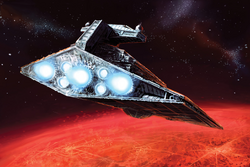
The Imperial-class was produced in large numbers and was the premier warship class of the Galactic Empire.[4] All known variants were 1,600 meters long (one mile). Compared to most common frigates and downscaled cruisers[6] known from the days of the Old Republic, the Imperial-class was a huge warship,[32][26] but in the Imperial Navy, it was one of the Empire's mid-sized mainline warships,[12] like its predecessor had been for the Republic.[6] The hulls of the Imperial-class were painted in Star Destroyer White, a purely economic choice as it was the only variety of paint that was produced in sufficient quantities to coat the Empire's immense number of warships.
Crew requirements
According to officially available statistics, Imperial-class Star Destroyers had at least 37,000 officers and crew. Counting the stormtrooper complement (one division or legion, 9,700 men) would total 46,700. This would include a stormtrooper detachment, starfighter pilots, and support craft pilots.[4] Differing from many other Imperial vessels, recreational facilities provided entertainment for off-duty personnel and "guest rooms' could accommodate Imperial VIPs.[33]
Offensive and defensive systems
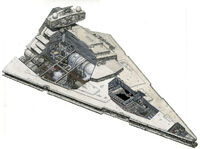
The Imperial I-class Star Destroyer possessed a main battery of six heavy turbolasers and two heavy ion cannons, arranged in four dual mounts flanking the ship's tower structure.[32]
Like with several other Star Destroyer classes, the designers did take advantage of their wedge shape to give the heavy cannons the ability to focus on _targets in the forward firing arc that were level with the ship.[6][32]
Numerous smaller and medium guns were mounted around the ship to ward off attacks against lesser ships not capable of being _targeted by the main battery. They varied in size; some were designed as point-defense cannon to destroy incoming missiles and starfighters while others engaged lesser capital ships.[32] Some ships, such as Emancipator, were refitted with proton torpedo launchers. Three triple-gun turrets were mounted on the ridge of the ship, just forward of the lowest, forwardmost terrace of the dorsal superstructure.[32]
Mounted just beyond the forward tip of the attack hangar (see fighter complement), were two large ventral turbolasers, which sat near the corners of the massive hangar.[24]
Complement
Imperial-class Star Destroyers typically carried a standard Imperial wing of 6 TIE squadrons, for a total of 72 starfighters.[4][32]
The standard wing included four TIE Fighter squadrons (one squadron often referred to be a reconnaissance squadron of TIE/rc starfighters), one squadron of TIE Interceptors, one squadron of TIE Bombers (lower priority ships had to make do with TIE/gt starfighter-bombers). Often one or two flights in a fighter squadron were TIE/fc starfighters. Sometimes one of the fighter squadrons was used for training purposes. By the Battle of Endor, one of these fighter squadrons had been phased out in favor of a second squadron of TIE Interceptors.[34]
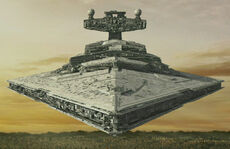
The attack hangar was located on the underside on the ship and was guarded by a set of armored doors. TIE fighter service and refueling bays, and TIE launch hangars surrounded the main hangar. TIEs were launched from cycling racks and pilots boarded from overhead gantries and were released into space as they disengaged from the front position in the racks.[32]
Returning fighters landed in separate hangars and then were guided by small tractor beams into receiver-carriers. The receivers carried the TIE to a debarkation station where the pilot would exit. Once moved through the transfer tunnels to a launch hangar, the fighter could be serviced and refueled in a separate bay. In the hangar, the TIEs were cycled through a launch rack and ready for the next launch. The small forward hangar was for shuttle craft carrying high-ranking officials. The forward hangar was also used as a back-up to the main hangar.[32]
These ships carried 9,700 troops, as well as massive war vehicles such as AT-AT and AT-ST walkers.[4] AT-AT barges and other landing craft were used to deliver ground assault forces to a planet's surface.[4][32][35][25] Although larger landing craft could only be carried onboard bigger Imperial vessels,[12] the Imperial-class could transfer a large number of heavy walkers to smaller transport ships via a detachable rail system.[36]
The Star Destroyer could use its guns and TIE starfighters to support any surface action. If a planet required a lasting presence, a Star Destroyer could quickly deploy a prefabricated garrison base.[4] Like most other Star Destroyer models, the Imperial-class was capable of entering atmospheres and supporting ground operations directly.[37][38][39]
Propulsion systems
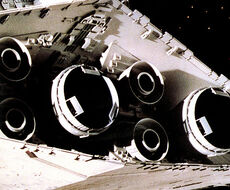
There were entire planets that, throughout their history, did not expend as much power as an Imperial-class ship did in one hyperspace jump.[4] The hyperspace generator was located along the ship's ventral surface.[33] A massive solar ionization reactor bulged from the ventral spine, annihilating hypermatter as fuel to power the ship. Auxiliary reactors flanked the main reactor and the three reactors were connected to the three main engines. In addition, the backup engines were connected to additional reactors as well.[32]
Catastrophic release braces were located underneath the ventral reactor bulge, in case of emergencies where the core of the main reactor had to be ejected from the ship.[40]
As designed, the Imperial-class had a Class 2 hyperdrive with a Class 8 emergency backup.[7] However, KDY's practice of subcontracting out the design to meet Imperial demands led to occasional design quirks: Star Destroyers built by the Corellian Engineering Corporation were considerably faster, both at sublight and hyperspace speeds.[3]
For sublight propulsion, the Imperial-class relied on an array of three primary Destroyer-I ion engines produced by KDY specifically for the vessels. For emergency situations requiring additional thrust, the Imperial-class could use its four Gemon-4 ion engines.[34] The engines were capable of accelerating the ship with a force of several thousand g.[25]
Bridge tower
The command bridge tower of the Imperial-class Star Destroyer was massive, and the command bridge followed a design similar to that of many other KDY warship classes, such as the Venator-class[41] and the Executor-class designs.[12] The sensor array on top of the Mk. I's tower had support beams running diagonally across it. These would later be substituted for vertical ones during a minor refit, which made the array look similar to the one on Mk. II vessels.[42] The two globes atop the bridge tower served two purposes: aiding both in hyperspace communication and deflector shield generation. The proximity of the deflector shield generators made the bridge tower one of the most protected parts of the Star Destroyer[34][37]
History
Republic origin

The Imperator-class was designed as a massive, powerful, mid-sized warship,[6] and appeared in limited numbers during the Clone Wars, where it served in several Republic task forces.[5] As the war neared its end in 19 BBY, the production lines of new Imperator-class and Tector-class destroyers expanded, while the lines for the older, lighter Venator-class slowed down.[6]
The first vessel was named the Executrix,[27] while the second was the Exactor, which later served as the first personal flagship of the Imperial enforcer Darth Vader.[29] There was also an Imperator among the Mk.I models, sharing the class name.[43] Following the Great Jedi Purge and the establishment of the Galactic Empire in 19 BBY, the Imperator model was renamed Imperial-class[6] and production of the class was increased even further[29] and refined.[28] Despite the name change, some Imperial documents continued to use the original name to identify the class.[23]
Imperial service
I hate the look of these new mass-produced Imperator-class Destroyers. None of the artistry that went into the old Acclamators or Venators—even the Victory Twos. So goes elegance.Brudi Gayn
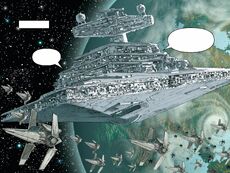
Imperial-class Star Destroyers had a distinguished career in the Imperial Starfleet, where they symbolized the Empire's military might (for better or worse). Eventually, these Star Destroyers rendered older vessels, like the Venator-class, obsolete.[44]
Capable of laying waste to entire worlds (provided those worlds did not have planetary shields), the Imperial-class became infamous as the prime enforcer of Imperial rule, and even served as a small, peacekeeping battleship.[4][32] According to official records, over 25,000 were eventually produced.[45] The Navy's immense demand for Star Destroyers led Kuat Drive Yards to subcontract the design out to various other shipwrights, which occasionally led to a number of design quirks: Star Destroyers built by the Corellian Engineering Corporation were considered the fastest ships in the Imperial Navy, both at sublight and hyperspace speeds.[3]
Within sector-level fleets, the Imperial-class Star Destroyer served a central battleship role, being the flagship of the unit known as the "Battle Squadron." A Sector Group was responsible for patrolling a given sector and comprised 24 Star Destroyers.[33] It was also observed to operate more or less independently and often far from support ships and facilities. Through many operations, the Imperial-class functioned as a destroyer, a capital ship fast enough to chase down blockade runners and protect fleets. As an escort, it also supported Imperial Star Cruisers and Star Dreadnoughts in fleet combat.[46][12]
When he assaulted Hoth, Darth Vader commanded the Star Dreadnought Executor and brought along a flotilla of Imperial-class vessels from Death Squadron to assault the planet. The Rebellion's heavy ion cannon, powered by the reactor of a battlecruiser, easily overwhelmed individual Star Destroyer shields and rapidly disabled ships in orbit.[42][12]
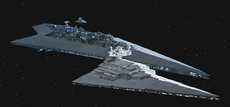
In the New Republic era, Imperial-class Star Destroyers continued in the escort role for larger vessels in campaigns like Operation Shadow Hand in 10 ABY. The Super Star Destroyer Allegiance led a task force of Imperial-class ships and World Devastators during the First Battle of Mon Calamari.[47] This was one of many fleets that struck out from the Core as part of the operation, which was aimed at taking back most of the Galactic Empire's former territories. Operation Shadow Hand saw a relatively heavy use of different types of Super Star Destroyers supported by Star Destroyers.[47]
Later service
Some New Republic Imperial I-class Star Destroyers, like the Mon Mothma, were refitted to include gravity well projectors.[48]
Private service
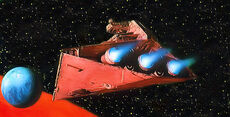
One Star Destroyer was operated by a private individual—the Errant Venture, formerly the Virulence, which had been captained by the smuggler Booster Terrik. The warship was claimed by Booster in the wake of the decisive Battle of Thyferra that concluded the Bacta War,[49] but was in poor condition for many years owing to the great cost of maintaining such a large vessel. In addition, she was stripped of the vast majority of her armament: only ten turbolasers were permitted, and even those were not always functional.[50]
Years later, the vessel received a comprehensive refit in exchange for Booster permitting its use in a New Republic special-operations raid on an Imperial base. The most notable part of this refit was a deep red paint job instead of the classic Imperial white.[51]
Variants
Imperial II-class Star Destroyer
Several variant designs and refits were made using the Imperial-class as a basis. The most famous and widely produced, was the Imperial II-class Star Destroyer, the second iteration of the class. It included improved armor and weaponry, a different sensor tower and other cosmetic differences.[4]
Imperial-class variant
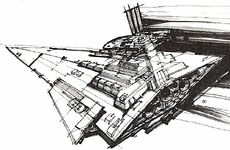
Similar to how some Victory-class vessels borrowed design elements from the Imperial-class,[52] at least one Imperial variant borrowed elements of the Victory-class. It had an elongated command tower and wing-structures on the side of the superstructure.[19]
Interdictor-class Star Destroyer
Another variant was the Interdictor-class Star Destroyer, heavily modified Imperial-class ships that were fitted with gravity-well generators and utilized to halt hyperspace travel for enemy ships.[53]
Behind the scenes
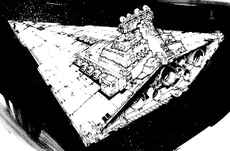
There has been some disagreement over the name of the class. Early material by Geoffrey Mandel, now considered unofficial, showed the Star Destroyer model smaller than they later appeared. The class name Imperator was used for these drawings, and the ships were to be produced at the Gyndine shipyards. Many of the designs were greatly upscaled shortly before production began.
Star Wars: Revenge of the Sith Incredible Cross-Sections put the debate to rest, by clarifying the issue: while the class was originally named Imperator, it was renamed Imperial at some point after the Great Jedi Purge. Later sources would reference Imperator, including the novel Dark Lord: The Rise of Darth Vader and the Star Wars Legends section on the Venator-class Star Destroyer's profile in the original Databank.[28]
The word "imperator" is Latin and was used as a title for an army commander in the Roman Republic. Later, during the Roman Empire, it became a title worn by the emperors and signified "the supreme power of the Roman emperor." It also acted as the direct namesake for the term Emperor, as the latter term was the Old French spelling for the aforementioned term.[54] Some critics suggest that naming one of the Empire's class of ships Imperial is redundant.
Based on an animatic of a Revenge of the Sith TV spot, an Imperator-class Star Destroyer was scheduled to appear during the final scenes of the film, but was apparently cut and replaced with a Venator-class in post-production.
Imperial-class Star Destroyers have featured prominently in many Star Wars computer games. However, they have generally been weakened to allow the player some chance of defeating them with a starfighter. Some of these game mechanics have included shooting sensor globes and reactor bulbs to bring down the whole ship.
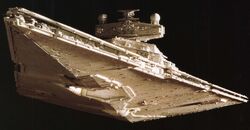
Imperial-class Star Destroyers have sometimes been referred to as cruisers. The book Starships of the Galaxy (Saga Edition) referred to most common Star Destroyers as being classified as "star cruisers," with lowercase letters. It also noted that unlike the term "Star Destroyer," "star cruiser" means "a naval cruiser that travels through space."[55] Since the Imperial-class has also been called a "star destroyer," the class can be seen as either a naval destroyer or a cruiser, given similarities in their roles. Imperial-class ships have also been described as battleships (more specifically, "peacekeeping battleships").[2] This is presumably because one Imperial constituted a line on its own. Revenge of the Sith Incredible Cross-Sections also mentions warships being "downscaled," depicting at least two separate classification systems, one where regular Star Destroyers are destroyers and another where they are battleships.
Numerous Expanded Universe sources state that the Imperial I is armed with 60 identical turbolasers and 60 identical ion cannons. However, analysis of the Star Destroyer models used in the films shows that this is a flawed description. The Star Wars: Incredible Cross-Sections book followed the movie model more closely, describing three twin-barreled heavy turbolasers and one ion cannon on each side of the command tower, one quad-laser cannon in each side trench, three cannons in front of the terrace superstructure, and numerous smaller guns lining each trench, as well as several tractor-beam projectors located inside the vessel.
The Star Wars Technical Journal offers a slightly different number for the crew requirement: 4,520 officers and 32,565 enlisted men making a total crew of 37,085.
Appearances
- Star Wars: Battlefront
- Star Wars: Battlefront II
- Star Wars: Battle for the Republic
- Dark Times 4
- Dark Times 5
- Dark Lord: The Rise of Darth Vader (and unabridged audiobook) (As Imperator-class)
- Darth Vader and the Lost Command 1
- Darth Vader and the Lost Command 2
- Darth Vader and the Lost Command 4
- Dark Times—Out of the Wilderness 5
- Dark Times—Fire Carrier 1 (Appears in hologram)
- Dark Times—A Spark Remains 1 (Appears in hologram)
- Darth Vader and the Cry of Shadows 4
- "The Queen of Air and Darkness" – Dawn of Defiance campaign
- "Echoes of the Jedi" – Dawn of Defiance campaign
- "The Core of Corruption" – Dawn of Defiance campaign
- The Paradise Snare (First identified as Imperator-class)
- The Hutt Gambit (Mentioned only)
-
 "Routine" — Star Wars Tales 2
"Routine" — Star Wars Tales 2 -
 A Hunter's Fate: Greedo's Tale on Hyperspace (article) (content obsolete and backup link not available)
A Hunter's Fate: Greedo's Tale on Hyperspace (article) (content obsolete and backup link not available) - Boba Fett: Enemy of the Empire 1
- Boba Fett: Enemy of the Empire 2
- Boba Fett: Enemy of the Empire 3
- Boba Fett: Enemy of the Empire 4
- Star Wars: The Force Unleashed
- Star Wars: The Force Unleashed novelization (and unabridged audiobook)
- Star Wars: The Force Unleashed graphic novel (In flashback(s))
- Rookies: Rendezvous
- Rookies: No Turning Back
- Star Wars Adventures: Han Solo and the Hollow Moon of Khorya
- Death Troopers (and audiobook)
- Empire 8
- Star Wars: Empire at War
- Star Wars: Empire at War: Forces of Corruption
- "The Farlander Papers" — Star Wars: X-Wing
- Star Wars: X-Wing
- Empire 5
- Star Wars: Rebel Assault
- Star Wars: Force Commander
- Star Wars Journal: The Fight for Justice (Indirect mention only) (as Imperial cruiser)
- Star Wars Journal: Captive to Evil
- Star Wars: Episode IV A New Hope
- Star Wars: A New Hope novelization (and unabridged audiobook) (First appearance, in book) (First identified as Imperial cruiser)
- Star Wars: Episode IV A New Hope junior novelization
- Super Star Wars
- Star Wars (1977) 1 (colorized in Star Wars: A Long Time Ago... Volume 1: Doomworld and Star Wars: Episode IV — A New Hope)
- Droids (1986) 6
- R2-D2's Mission: A Little Hero's Journey
- Star Wars: Rogue Squadron II: Rogue Leader
- Star Wars: Rogue Squadron III: Rebel Strike
- Star Wars Missions 17: Darth Vader's Return (Mentioned only)
- Star Wars Missions 18: Rogue Squadron to the Rescue (Mentioned only)
-
 "Small Favors" — Star Wars Adventure Journal 12
"Small Favors" — Star Wars Adventure Journal 12 - "The Second Kessel Run" (colorized in Classic Star Wars: The Early Adventures 6)
- Star Wars Missions 9: Revolt of the Battle Droids (Mentioned only)
- Empire 25
- Empire 28
- Graveyard of Alderaan (also reprinted in Classic Adventures: Volume Two)
- "Planet of Kadril"
- "Gambler's World" (colorized in Classic Star Wars: The Early Adventures 1–3)
- "Princess Leia, Imperial Servant" (colorized in Classic Star Wars: The Early Adventures 5)
- "Bring Me the Children" (colorized in Classic Star Wars: The Early Adventures 7)
- "As Long As We Live..." (colorized in Classic Star Wars: The Early Adventures 8)
- Star Wars (1977) 38 (colorized in Star Wars: A Long Time Ago... Volume 2: Dark Encounters)
- The Star Wars Holiday Special
- "Side Trip" (also reprinted in Hyperspace: The Official Star Wars Fan Club)
- Star Wars: TIE Fighter
- "The Stele Chronicles" — Star Wars: TIE Fighter
- Star Wars: Episode V The Empire Strikes Back
- Star Wars: Episode V The Empire Strikes Back junior novelization
- Star Wars: The Empire Strikes Back novelization (and unabridged audiobook)
- Star Wars (1977) 40 (colorized in Star Wars: A Long Time Ago... Volume 3: Resurrection of Evil and Star Wars: Episode V — The Empire Strikes Back)
- Star Wars: X-Wing Alliance
- Star Wars (1977) 50 (colorized in Star Wars: A Long Time Ago... Volume 3: Resurrection of Evil)
-
 "Slaying Dragons" — Star Wars Adventure Journal 9 (also reprinted in Tales from the Empire and Hyperspace: The Official Star Wars Fan Club) (Indirect mention only)
"Slaying Dragons" — Star Wars Adventure Journal 9 (also reprinted in Tales from the Empire and Hyperspace: The Official Star Wars Fan Club) (Indirect mention only) -
 Ewoks — "Battle for the Sunstar"
Ewoks — "Battle for the Sunstar" - Star Wars: Rebel Assault II: The Hidden Empire
- Star Wars: Shadows of the Empire novel
- Star Wars (1977) 78 (colorized in Star Wars: A Long Time Ago... Volume 5: Fool's Bounty) (Mentioned only)
- The Rise and Fall of Darth Vader
- Star Wars: Episode VI Return of the Jedi
- Star Wars Journal: Hero for Hire (Indirect mention only)
- The Mandalorian Armor (In flashback(s)) (Appears in hologram)
- Slave Ship (Mentioned only)
- A New Hope: The Life of Luke Skywalker (and audiobook)
- Star Wars (1977) 107 (colorized in Star Wars: A Long Time Ago... Volume 7: Far, Far Away)
- Star Wars (1977) 108
- Star Wars: Jedi Knight: Dark Forces II
-
 "A Glimmer of Hope" — Star Wars Adventure Journal 1 (also reprinted in The Best of the Star Wars Adventure Journal, Issues 1-4)
"A Glimmer of Hope" — Star Wars Adventure Journal 1 (also reprinted in The Best of the Star Wars Adventure Journal, Issues 1-4) -
 "Endgame" — Endgame (Reprinted and collected in The DarkStryder Campaign, Deluxe) (Indirect mention only)
"Endgame" — Endgame (Reprinted and collected in The DarkStryder Campaign, Deluxe) (Indirect mention only) - "Crisis of Faith" — Heir to the Empire: The 20th Anniversary Edition
-
 "Crossroads" on Hyperspace (article) (content now obsolete; backup link on Suvudu)
"Crossroads" on Hyperspace (article) (content now obsolete; backup link on Suvudu) - Tatooine Ghost
-
 "Mission to Zila" — Star Wars Adventure Journal 3 (also reprinted in Hyperspace: The Official Star Wars Fan Club) (Mentioned only)
"Mission to Zila" — Star Wars Adventure Journal 3 (also reprinted in Hyperspace: The Official Star Wars Fan Club) (Mentioned only) - Heir to the Empire (and unabridged audiobook)
- Dark Force Rising (and unabridged audiobook)
- The Last Command (and unabridged audiobook)
- Dark Empire 1 (Wreckage)
- Dark Empire 2
- Dark Empire 3
- Dark Empire 4
- Dark Empire 6
- Jedi Search
- Dark Apprentice
- Champions of the Force
- I, Jedi (and unabridged audiobook)
-
 "Shades of Gray" on Hyperspace (article) (content now obsolete; backup link on Suvudu)
"Shades of Gray" on Hyperspace (article) (content now obsolete; backup link on Suvudu) - Darksaber
- Star Wars: Jedi Knight: Jedi Academy
- Specter of the Past (and unabridged audiobook)
- Vision of the Future (and unabridged audiobook)
Non-canon appearances
- ° Star Wars Infinities: A New Hope
- ° Star Wars: Tag & Bink Are Dead
-
 "Trooper" — Star Wars Tales 10
"Trooper" — Star Wars Tales 10 -
 "Prey" — Star Wars Tales 11
"Prey" — Star Wars Tales 11 - LEGO Star Wars: The Video Game
- LEGO Star Wars II: The Original Trilogy
- LEGO Star Wars: The Complete Saga
- Star Wars: The Force Unleashed — Ultimate Sith Edition
Sources
- The Star Wars Sourcebook
- The Star Wars Rules Companion
- Imperial Sourcebook
- Galaxy Guide 3: The Empire Strikes Back
- Heir to the Empire Sourcebook
- Star Wars: The Roleplaying Game, Second Edition
- Dark Empire Sourcebook
- The Star Wars Sourcebook, Second Edition
- Star Wars Screen Entertainment
- TIE Fighter: The Official Strategy Guide
- Imperial Sourcebook, Second Edition
- Star Wars Technical Journal
- TIE Fighter: Defender of the Empire: Official Secrets & Solutions
- Star Wars Gamemaster Screen, Revised
- The Illustrated Star Wars Universe
-
 Star Wars Customizable Card Game — Premiere Limited (Card: Imperial-Class Star Destroyer) (backup link)
Star Wars Customizable Card Game — Premiere Limited (Card: Imperial-Class Star Destroyer) (backup link) - ° Star Wars: The Power of the Force toy line (1995)
- The Essential Guide to Vehicles and Vessels
- The Thrawn Trilogy Sourcebook
- TIE Fighter Collector's CD-ROM: The Official Strategy Guide
- Star Wars: The Roleplaying Game, Second Edition, Revised and Expanded
- Galaxy Guide 3: The Empire Strikes Back, Second Edition
- Cracken's Threat Dossier
- Star Wars Trilogy Sourcebook, Special Edition
- Star Wars: Rebellion: Prima's Official Strategy Guide
- The Far Orbit Project
- Star Wars: Incredible Cross-Sections
- Star Wars: X-Wing Alliance: Prima's Official Strategy Guide
- ° Star Wars: Power of the Jedi
- Rebellion Era Sourcebook
- The Official Star Wars Fact File 13 (KUA 1-4: Kuat Drive Yards)
- Star Wars Roleplaying Game Revised Core Rulebook
- The New Essential Guide to Vehicles and Vessels
-
 Star Wars Trading Card Game — The Empire Strikes Back (Card: Imperial II-Class Star Destroyer) (backup link)
Star Wars Trading Card Game — The Empire Strikes Back (Card: Imperial II-Class Star Destroyer) (backup link) - Star Wars: Revenge of the Sith Incredible Cross-Sections (As both Imperator- and Imperial-class)
- Star Wars: Empire at War: Prima Official Game Guide
- Star Wars: Empire at War: Forces of Corruption Expansion: Prima Official Game Guide
![]() Star Wars Miniatures — Starship Battles
Star Wars Miniatures — Starship Battles
- Star Wars: Complete Cross-Sections (As both Imperator- and Imperial-class)
-
 Episode IV Visual Guide — Chapter 3: Imperial Boarding Party on StarWars.com (content now obsolete; backup link)
Episode IV Visual Guide — Chapter 3: Imperial Boarding Party on StarWars.com (content now obsolete; backup link) - Starships of the Galaxy, Saga Edition
- Star Wars: The Clone Wars: The Visual Guide (As Imperator-class)
- The Complete Star Wars Encyclopedia (As both Imperator- and Imperial-class)
-
 Tinker, Tailor, Soldier, Praji on Hyperspace (article) (content obsolete and backup link not available)
Tinker, Tailor, Soldier, Praji on Hyperspace (article) (content obsolete and backup link not available) - Galaxy of Intrigue
-
 Imperial Star Destroyer in the Databank (content now obsolete; backup link)
Imperial Star Destroyer in the Databank (content now obsolete; backup link) -
 Republic attack cruiser in the Databank (content now obsolete; backup link) (As both Imperator- and Imperial-class)
Republic attack cruiser in the Databank (content now obsolete; backup link) (As both Imperator- and Imperial-class) - Millennium Falcon Owner's Workshop Manual
-
 Star Wars: The Card Game — Core Set (Card: Devastator) (Picture only)
Star Wars: The Card Game — Core Set (Card: Devastator) (Picture only) -
 Star Wars: The Card Game — A Dark Time (Card: Ion Cannon Burst) (Picture only)
Star Wars: The Card Game — A Dark Time (Card: Ion Cannon Burst) (Picture only) -
 Star Wars: The Card Game — Edge of Darkness (Card: Imperial I-class Star Destroyer)
Star Wars: The Card Game — Edge of Darkness (Card: Imperial I-class Star Destroyer) -
 Star Wars: The Card Game — Escape from Hoth (Card: The Executor Arrives) (Picture only)
Star Wars: The Card Game — Escape from Hoth (Card: The Executor Arrives) (Picture only) -
 "Reigniting the Rebellion!" — Star Wars Insider 146
"Reigniting the Rebellion!" — Star Wars Insider 146 -
 Star Wars: The Card Game — Balance of the Force (Card: Thunderflare) (Picture only)
Star Wars: The Card Game — Balance of the Force (Card: Thunderflare) (Picture only) -
 Star Wars: X-Wing Miniatures Game — Tantive IV Expansion Pack (Card: Tantive IV) (Picture only)
Star Wars: X-Wing Miniatures Game — Tantive IV Expansion Pack (Card: Tantive IV) (Picture only) - Star Wars: Age of Rebellion Core Rulebook
- Star Wars: Imperial Handbook: A Commander's Guide
Notes and references
- ↑ 1.00 1.01 1.02 1.03 1.04 1.05 1.06 1.07 1.08 1.09 1.10 1.11 1.12 1.13 Imperial Sourcebook, Second Edition
- ↑ 2.00 2.01 2.02 2.03 2.04 2.05 2.06 2.07 2.08 2.09 2.10 2.11 2.12 2.13 2.14 2.15 2.16 2.17 2.18 2.19 Star Wars: Complete Cross-Sections
- ↑ 3.0 3.1 3.2 The Essential Guide to Warfare
- ↑ 4.00 4.01 4.02 4.03 4.04 4.05 4.06 4.07 4.08 4.09 4.10 4.11 Imperial Sourcebook
- ↑ 5.0 5.1 5.2 5.3 5.4 Star Wars: The Clone Wars: The Visual Guide
- ↑ 6.0 6.1 6.2 6.3 6.4 6.5 6.6 6.7 6.8 Star Wars: Revenge of the Sith Incredible Cross-Sections
- ↑ 7.0 7.1 7.2 7.3 7.4 7.5 Star Wars: Age of Rebellion Core Rulebook
- ↑ 8.00 8.01 8.02 8.03 8.04 8.05 8.06 8.07 8.08 8.09 8.10 8.11 Star Wars: Behind the Magic
- ↑ Star Wars: Head-to-Head
- ↑ 10.0 10.1 The Galactic Empire—Ships of the Fleet
- ↑ Inside the Worlds of Star Wars Trilogy, with the Executor 100 times more massive, it requires at least 100 times more energy to move and vice versa.
- ↑ 12.0 12.1 12.2 12.3 12.4 12.5 12.6 12.7 Star Wars: Complete Locations
- ↑ From a Richard Edlund interview in CINEFEX February 1983 issue
- ↑ Star Wars Screen Entertainment
- ↑ 15.0 15.1 15.2 15.3 15.4 15.5 "The Stele Chronicles" — Star Wars: TIE Fighter
- ↑ Star Wars Roleplaying Game Revised Core Rulebook
- ↑ 17.0 17.1 17.2 Darth Vader and the Cry of Shadows 4
- ↑ Dark Times 4
- ↑ 19.0 19.1 The Star Wars Sourcebook
- ↑ The Force Unleashed Campaign Guide
- ↑ Star Wars: X-Wing Alliance
- ↑ Star Wars Battlefront II: Prima Official Game Guide
- ↑ 23.0 23.1 Acme Specplate Imperial Star Destroyer blueprint
- ↑ 24.0 24.1 24.2 Star Wars: Episode IV A New Hope
- ↑ 25.0 25.1 25.2 The New Essential Guide to Vehicles and Vessels
- ↑ 26.0 26.1 26.2
 Imperial Star Destroyer in the Databank (content now obsolete; backup link)
Imperial Star Destroyer in the Databank (content now obsolete; backup link)
- ↑ 27.0 27.1 The Complete Star Wars Encyclopedia
- ↑ 28.0 28.1 28.2
 Republic attack cruiser in the Databank (content now obsolete; backup link)
Republic attack cruiser in the Databank (content now obsolete; backup link)
- ↑ 29.0 29.1 29.2 29.3 Dark Lord: The Rise of Darth Vader
- ↑ Strike Force: Shantipole
- ↑ The Far Orbit Project
- ↑ 32.00 32.01 32.02 32.03 32.04 32.05 32.06 32.07 32.08 32.09 32.10 Star Wars: Incredible Cross-Sections
- ↑ 33.0 33.1 33.2 Star Wars Technical Journal
- ↑ 34.0 34.1 34.2 The Essential Guide to Vehicles and Vessels
- ↑ Star Wars: Force Commander
- ↑ Star Wars: X-Wing Rogue Squadron: Mandatory Retirement
- ↑ 37.0 37.1 Star Wars: The Force Unleashed
- ↑ Star Wars: Battlefront II
- ↑ Star Wars: Dark Empire II
- ↑
 Episode IV Visual Guide — Chapter 3: Imperial Boarding Party on StarWars.com (content now obsolete; backup link)
Episode IV Visual Guide — Chapter 3: Imperial Boarding Party on StarWars.com (content now obsolete; backup link)
- ↑ Star Wars: Episode III Revenge of the Sith
- ↑ 42.0 42.1 Star Wars: Episode V The Empire Strikes Back
- ↑ Dark Forces: Soldier for the Empire
- ↑ Star Wars: Revenge of the Sith: The Visual Dictionary
- ↑ Specter of the Past
- ↑ Rebellion Era Sourcebook
- ↑ 47.0 47.1 Star Wars: Dark Empire
- ↑ The New Jedi Order: Star by Star
- ↑ X-Wing: The Bacta War
- ↑ I, Jedi
- ↑ Vision of the Future
- ↑
 Star Wars Customizable Card Game — Death Star II Limited (no cardname specified!)
Star Wars Customizable Card Game — Death Star II Limited (no cardname specified!)
- ↑ Starships of the Galaxy
- ↑ University of Notre Dame Latin Dictionary and Grammar Aid
- ↑ Starships of the Galaxy, Saga Edition
